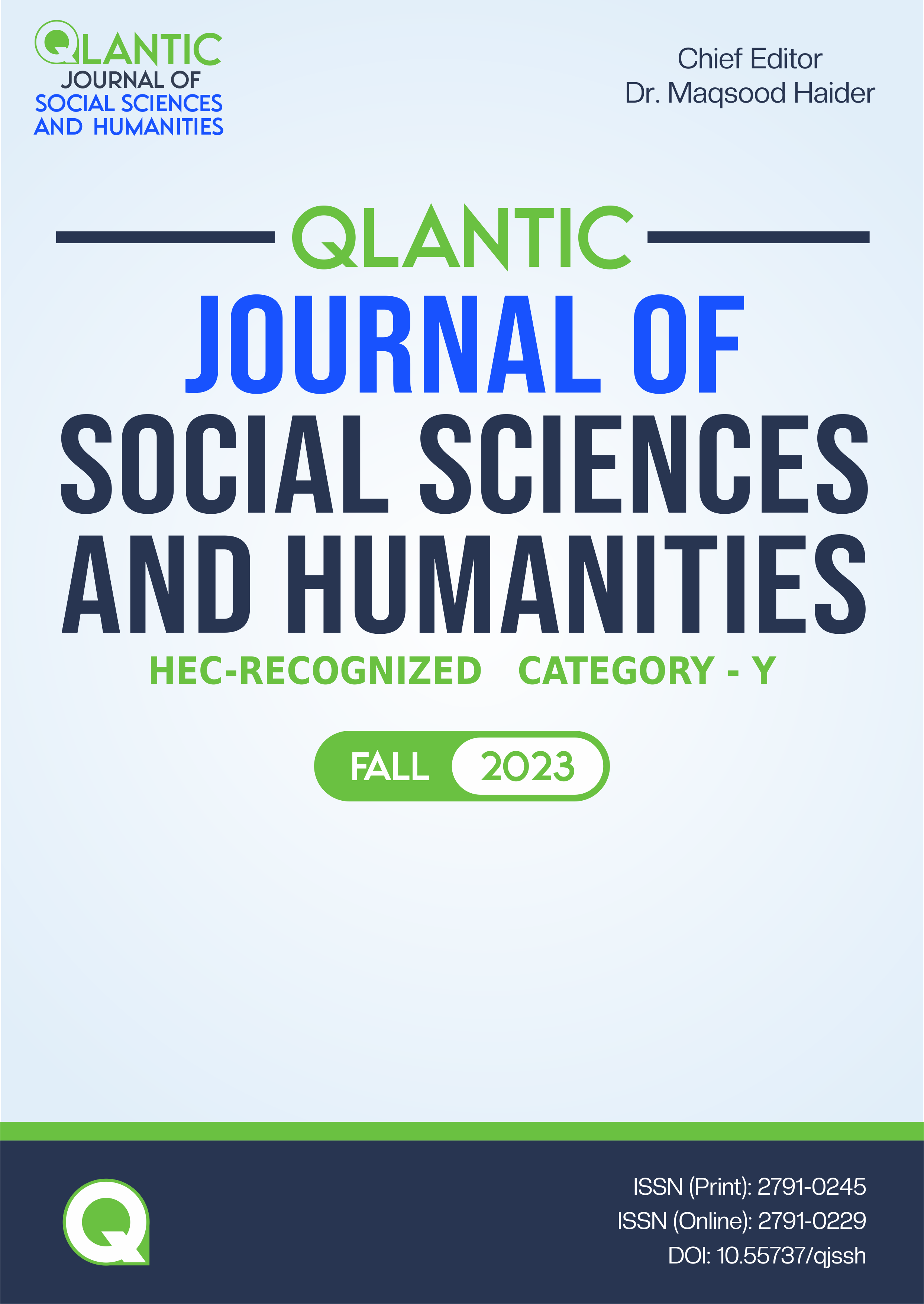A Comparative Mood Analysis of the English Speeches of General Qamar Javed Bajwa and General Pervaiz Musharraf
DOI:
https://doi.org/10.55737/qjssh.246171723Keywords:
Mood Analysis, Syntactic Analysis, Mood TypesAbstract
Mood refers to the transient emotional and mental state of an individual. This study delves into an examination of mood types present in the speeches of Qamar Javed Bajwa and Pervaiz Musharraf, drawing on M.A.K Halliday's theory. Its primary objective is to elucidate the prevalent mood structures within their speeches and to discern how these moods manifest the unique features of their oratory. Utilizing a descriptive qualitative approach and transcriptions of their speeches, the research scrutinized 316 lines of two army chiefs’ speeches. The findings unveiled the existence of three distinct mood types: declarative, interrogative, and imperative. Notably, Bajwa predominantly employed the declarative mood in 87% of his speech, while Musharraf consistently used it 90% of the time. The interrogative mood was a much rarer presence, appearing in just 1.15% of the speeches. The imperative mood featured in Bajwa's speech at a rate of 12% and in Musharraf's speech at 7.5%. It is worth noting that the declarative mood, which involves the provision of information, was the most frequently utilized mood in the speeches of both individuals.
References
Andrew, D. P., Pedersen, P. M., & McEvoy, C. D. (2020). Research methods and design in sport management. https://doi.org/10.5040/9781718221031
Butt, D., Fahey, R., Feez, S., Spinks, S., & Yallop, C. (2003). Sydney: Macquarie University. National Centre for English Language Teaching and Research.
Chan, E., & Unsworth, L. (2011). Image–language interaction in online reading environments: Challenges for students’ reading comprehension. The Australian Educational Researcher, 38(2), 181-202. https://doi.org/10.1007/s13384-011-0023-y
Christie, F., & Unsworth, L. (2000). Developing socially responsible language research. Researching language in schools and communities: Functional linguistic perspectives, 1-26.
Creswell, J. W. (2014). A concise introduction to mixed methods research. SAGE publications.
Eggins. (2004). An introduction to systemic functional linguistics, 2nd ed. New York: Continuum,
Forgas, J. P. (2002). Feeling and doing: Affective influences on interpersonal behavior. Psychological Inquiry, 13(1), 1-28. https://doi.org/10.1207/s15327965pli1301_01
Gerot, & Wignel, P. (1994). Making sense of functional grammar. New South Wales: Antipodean Educational Enterprises,
Halliday, M. A. K. (2000). An Introduction to Functional Grammar, Beijing: Foreign Language Teaching and Research Press.
Halliday, M. A. K. (2002). An Introduction to Functional Grammar. Beijing: Foreign Language.
Halliday, M. A. K. (2003). On language and linguistics. A&C Black.
Halliday, M. A. K., & C. Matthiessen. (2004). An Introduction to Functional Grammar: Third Edition. London: Edward Arnold
Halliday, M. A. K., & Matthiessen, C. M. (2013). Halliday's introduction to functional grammar. Routledge.
Halliday, M. A. K., & Matthiessen, C. M. I. M. (2014). Introduction to functional grammar, 4th ed. Oxon: Routledge,
Isaac, S., & Michael, W. B. (1981). Handbook in research and evaluation: For education and the behavioral sciences. EdITS.
Khan, Z., Kamran, U., & Umar, L. (2019). A Critical Discourse Analysis of President Musharraf's Speeches: Legitimizing War on Terror. Dialogue (Pakistan), 14(4), 232-241. https://www.qurtuba.edu.pk/thedialogue/The%20Dialogue/14_4/14_4_24.pdf
Kirumbi, A. B. (2018). Modelling the point spread function using principal component analysis. Department of Physics and Astronomy and College of Arts and Science. The University of Ohio p10, 12.
Marhamah, R. A. (2014). Interpersonal meaning analysis of muse song lyrics in black holes and revelations’ album. A Study Based On Systemic Functional Linguistics, Script of Student University of Yogyakarta.
Michalos, A. C. (Ed.). (2014). Encyclopedia of quality of life and well-being research (Vol.171). Dordrecht: Springer Netherlands.
Nacwaz, M., & Butt, H. S. N. (2022). Study of Action Verbs Used in the Speeches of General Raheel Sharif: A Pragmatic Analysis. Kashmir Journal of Language Research, 25(2),145-166. http://kjlr.pk/index.php/kjlr/article/view/329
Noor, D. M., Ali, M., Muhabat, F., & Kazemian, B. (2015). Systemic functional linguistics mood analysis of the last address of the holy prophet (pbuh). International Journal of Language and Linguistics. Special Issue: Critical Discourse Analysis, Rhetoric, and Grammatical Metaphor in Political and Advertisement Discourses, 3(5-1), 1-9. https://doi.org/10.2139/ssrn.2604000
Rahayu, I. A. (2022). An Analysis of Mood and Speech Function in the “Raya and the last Dragon” movie script by qui nguyen and adele lim. Jurnal Pendidikan Edutama.
Sarwat, S., Imran, M., Shahzad, M. W., & Sadia, M. H. (2023). Thematic Analysis Of The Novel"Flights" By Olga Tokarczuk Using The Pragma-Stylistics Approach. Journal of Positive School Psychology, 893-906.
Sembiring, J. A., & Habibah, L. A. (2022). Mood and Modality Analysis in the Chronicles of Mulan Movie. English Teaching and Linguistics Journal (ETLiJ), 3(2), 75-93. https://doi.org/10.30596/etlij.v3i2.10540
Shukla, S. (2020). Concept of population and sample. How to Write a Research Paper, June, 1-6.
Sipra, M. A., & Rashid, A. (2013). Critical discourse analysis of Martin Luther King's speech in socio-political perspective. SSRN Electronic Journal. https://doi.org/10.2139/ssrn.2928691
Thompson, G. (2000). Introducing Functional Grammar. Beijing: Foreign Language Teaching and Research Press.
Utomo, S., Rusiana, R., & Minarosa, P. (2018). The analysis of mood types in Steve Jobs’ and Barack Obama’s speeches. Refleksi Edukatika: Jurnal Ilmiah Kependidikan, 9(1), https://doi.org/10.24176/re.v9i1.2802
Published
Issue
Section
License
Copyright (c) 2023 Fatima Saleem, Waheed Shahzad, Dr. Muhammad Anwar Farooq

This work is licensed under a Creative Commons Attribution-NonCommercial 4.0 International License.





